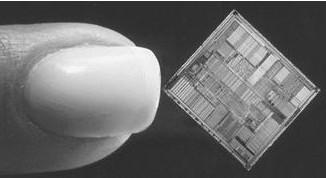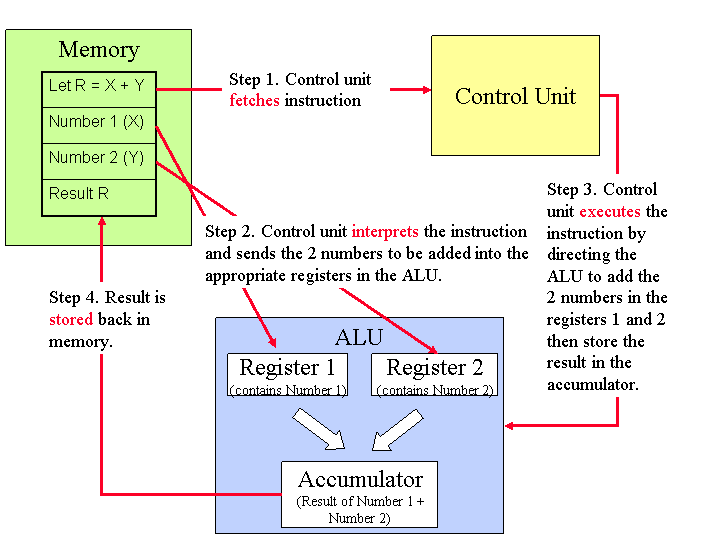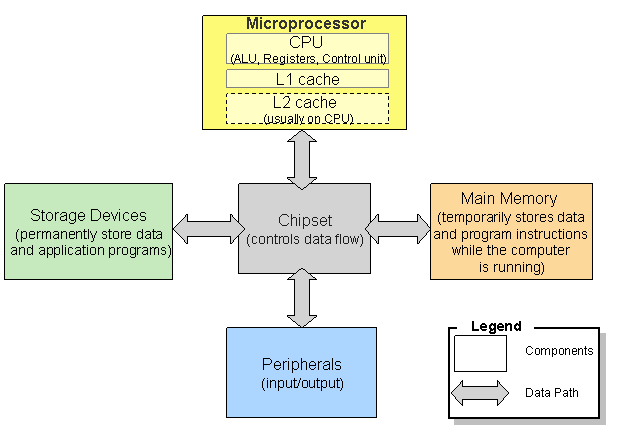
- •2.1.1 Processor Basics
- •Processor
- •Instruction Execution with the cpu
- •Performance: Factors and Measures
- •Types of Processors
- •2.1.2 Types of Memory
- •Cmos Memory
- •Summary
- •2.1.3 Lab: Benchmarking (Optional)
- •2.2.1 Connecting Peripherals
- •Expansion Slots and Cards
- •Usb and FireWire
- •Comparing Different Ports
- •2.2.2 Buses
- •2.2.3 Input/Output Devices
- •Input Devices
- •Cameras
- •Digital Camcorders
- •Scanners
- •Output Devices: Monitors and Projectors
- •Crt Monitors
- •Lcd Monitors
- •Projectors
- •Output Devices: Printers
- •Ink Printers
- •Dye-Sublimation Printers
- •Laser Printers
- •Comparing Printers
- •2.3.1 Disk Controller Interfaces
- •Ide Interface
- •Eide Master/Slave
- •2.3.2 Mass Storage
- •How Mass Storage Devices Differ from ram
- •Disk Drive Reliability
- •Optical Media: cDs versus dvDs
- •Magnetic Media
- •Optical versus Magnetic
- •Solid State
- •Comparing Storages
- •2.4.1 How Components Work Together
- •2.5.1 Moore's Law
- •2.5.2 Bottlenecks
- •Bottlenecks—Slowing a Process
- •Typical Bottlenecks
- •Eliminating Bottlenecks
- •2.5.3 Throughput and Latency
2.1.1 Processor Basics
Processor
Instruction Execution with the CPU
Performance: Factors and Measures
Types of Processors
Processor
A computer's processor is usually referred to as the microprocessor due to its size, which is about the size of your fingernail.

Figure 1 Microprocessor chip
A microprocessor processes all the instructions given to the computer (for example, add two numbers, execute program instructions, or print documents). Physically, the microprocessor is a single chip known as an integrated circuit (IC). Each chip is made out of silicon and it contains millions of transistors packed onto a chip.
The Intel Pentium M Processor, introduced on March 12, 2003, has 77 million transistors, and the width of the smallest wire on the chip is 0.13 micron, or 0.00000013 meter. As a reference, 0.13 micron is about 1/800 of the width of a human hair.The Intel Core i3-530 processor, introduced in January 2010, has 559 million transistors (382 million transistors on the CPU die and 177 million transistors on the graphics die), with a 0.032 micron width for the smallest traces on the chip.
The microprocessor is referred to as the Central Processing Unit (CPU). The job of a microprocessor is to execute a series of machine instructions. These instructions are procedures to carry out a task written in a form that the computer can understand.
Instruction Execution with the cpu
Instructions are stored in the computer's memory, RAM (random access memory), which will be covered in section 2.1.2 Types of Memory.
There are two main components of the CPU. One is the control unit, which accesses instructions stored in RAM, interprets what they mean, and then dispatches them. The other is the Arithmetic/Logic Unit (ALU) that performs arithmetic (i.e. addition, subtraction, multiplication, division) and logic (i.e. greater than, less than, equal to) operations needed to process the instructions.
There are four steps that the CPU performs when executing an instruction; they are called the fetch-execute cycle. The four steps are:
1. Fetch - The control unit gets the instruction from memory.
2. Interpret - The control unit decodes what the instruction means and directs the necessary data to be moved from memory to the ALU.
3. Execute - The control unit directs the ALU to perform the necessary arithmetic or logic operations.
4. Store - The result of the computation is stored in memory.
The diagram below illustrates the steps taken by the CPU to execute an instruction that adds two numbers. The instruction is: Let R = X + Y.

Figure 2 Fetch-Execute cycle
Another component of the microprocessor is the cache, a special high-speed memory that stores most recently used data in order to speed up the process of instruction execution. A cache can speed up data retrieval because recently used data is likely to be used again by the computer.
Level 1 (L1) cache memory or primary cache memory is located on the CPU to provide the CPU with the fastest access to data. There is also a slower cache, the Level 2 (L2) cache memory or secondary cache, located between the RAM and the CPU (sometimes on the CPU). If data cannot be found on either cache, it will be retrieved from RAM. Relative to the physical distance between the CPU and storage areas for data and instructions, data is retrieved more quickly from the L1 cache, then the L2 cache, and then the RAM.
The figure below illustrates how parts of a microprocessor fit within the other components in a computer.

Figure 3 Microprocessor view
